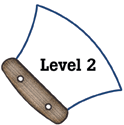|
National Science Education Standards
People have always had problems and invented tools and techniques (ways
of doing something) to solve problems. Trying to determine the effects
of solutions helps people avoid some new problems. (Page 138)
People continue inventing new ways of doing things, solving problems,
and getting work done. New ideas and inventions often affect other people;
sometimes the effects are good and sometimes they are bad. It is helpful
to try to determine in advance how ideas and inventions will affect other
people. (Page 140)
Science and technology have greatly improved food quality and quantity,
transportation, health, sanitation, and communication. These benefits
of science and technology are not available to all of the people in the
world. (Page 141)
|
|
Benchmarks
Technology extends the ability of people to change the world: to cut,
shape, or put together materials; to move things from one place to another;
and to reach farther with their hands, voices, senses, and minds. The
changes may be for survival needs, such as food, shelter, and defense,
for communication and transportation, or to gain knowledge and express
ideas. (Page 45)
The solution to one problem may create other problems. (Page 50)
Technology has been part of life on the Earth since the advent of the
human species. Like language, ritual, commerce, and the arts, technology
is an intrinsic part of human culture, and it both shapes society and
is shaped by it. The technology available to people greatly influences
what their lives are like. (Page 54)
|

